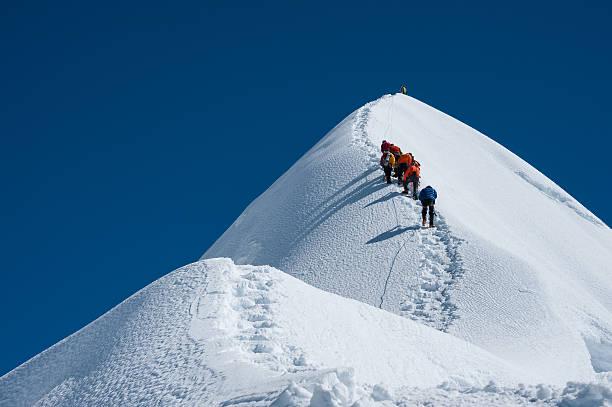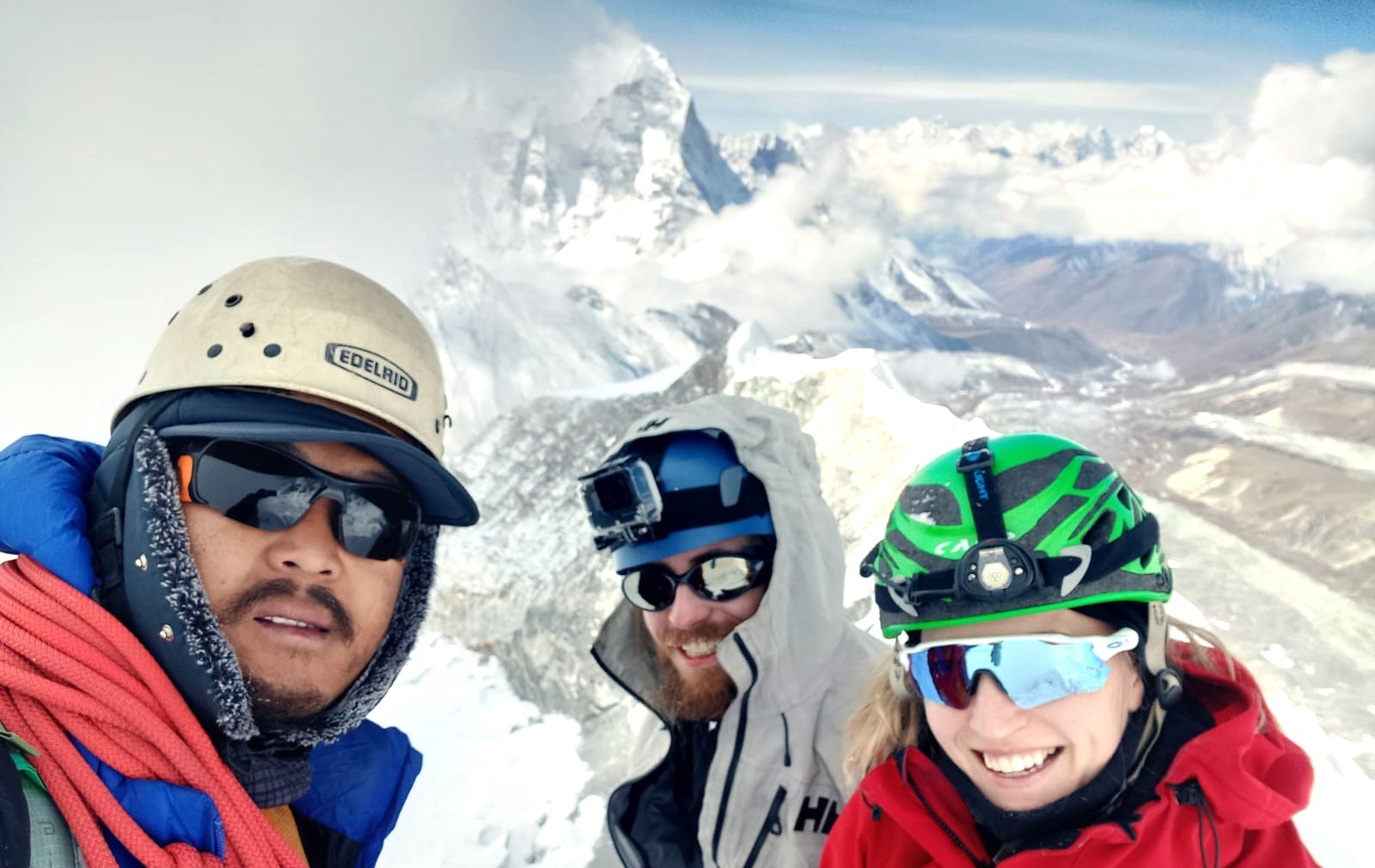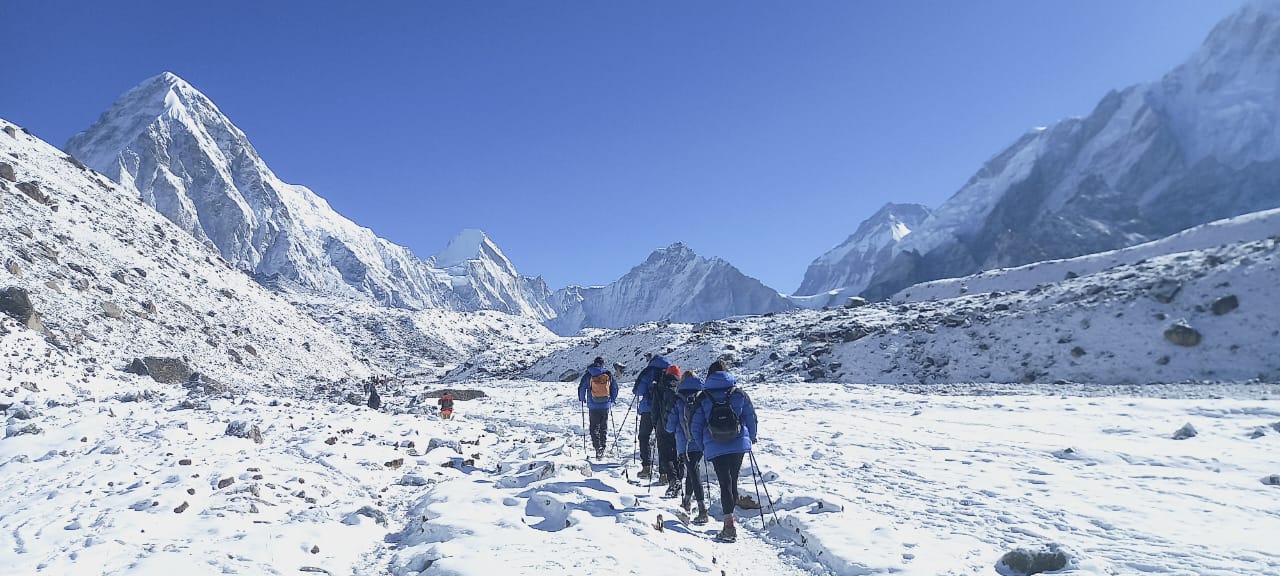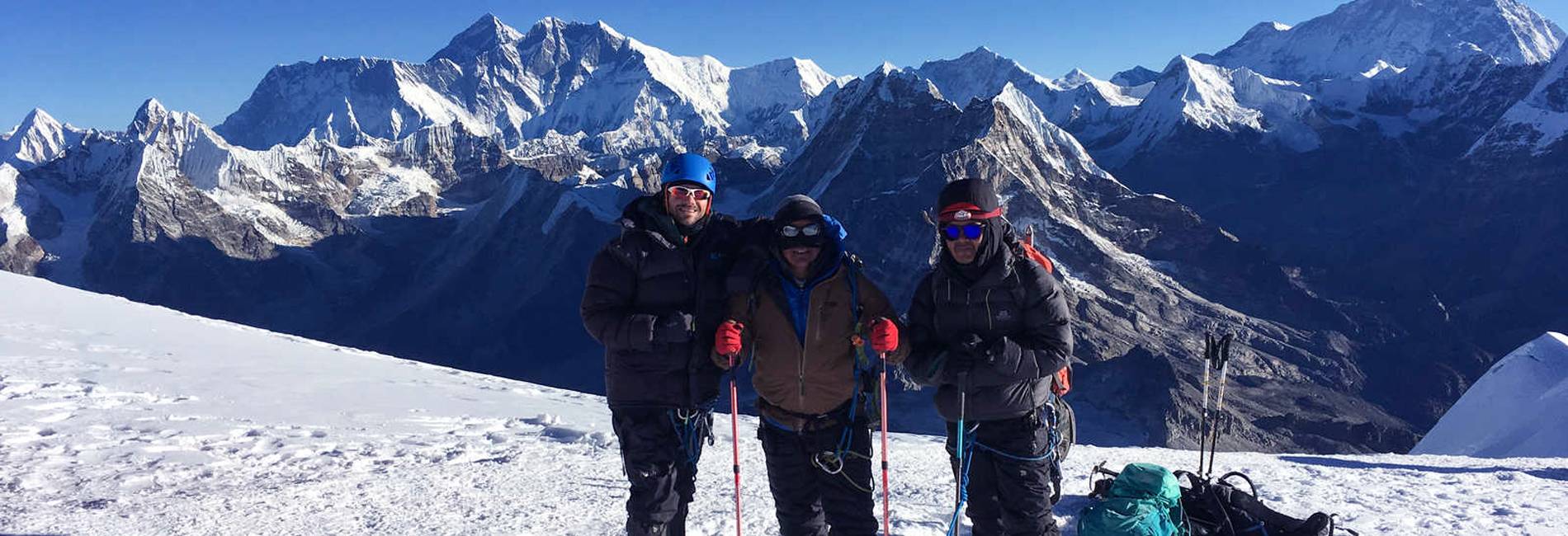26th August, 2025

Jul 31, 2024
Best Time for Island Peak Climbing
- Understanding Island Peak and Its Significance
- Overview of Climatic Conditions in the Region
- Spring Season Insights: March to May
- Summer Conditions and the Monsoon Effects
- Autumn Season Highlights: September to November
- Winter Challenges: December to February
- Comparing the Best Seasons for Climbers
- Essential Preparations for Each Climbing Season
- Final Thoughts: Selecting Your Optimal Climbing Window
Island Peak, also known as Imja Tse, is a popular climbing destination in Nepal's Everest region, renowned for its striking summit views and challenging ascent. Choosing the optimal time for climbing Island Peak is crucial for a successful and enjoyable expedition, as weather conditions and seasonal variations significantly impact the climbing experience.
Spring (March to May) is considered the prime season for climbing Island Peak. During this period, the weather is generally stable, and temperatures are relatively mild. The clear skies and minimal snowfall offer excellent visibility of the surrounding Himalayan peaks, including Everest, Lhotse, and Makalu. Spring provides longer daylight hours and favorable conditions for acclimatization, making it the most popular time for climbers. However, it is also the peak season, meaning that the trails and base camps can be crowded. Early bookings and permits are essential to avoid the rush and secure accommodations.
Autumn (September to November) is another ideal time for Island Peak climbing. The weather in autumn is crisp and clear, with stable conditions and less humidity than in summer. The post-monsoon period ensures that the trails are less muddy and the skies are often clear, providing stunning views of the Himalayas. Although temperatures begin to drop, the conditions remain manageable for most climbers. Autumn is slightly less crowded compared to spring, offering a more serene climbing experience. It’s crucial to prepare for colder temperatures and shorter daylight hours.

ISLAND PEAK CLIMBING
Sherpa Expedition & Trekking (Est.1977) are pleased to announce FOR ADVENTURERS the most awesome, exhilarating & unforgettable climbing and treks on offer anywhere today!...
Winter (December to February) and Summer/Monsoon (June to August) present significant challenges. Winter brings extreme cold, heavy snow, and potential avalanches, making climbing hazardous and difficult. The cold temperatures can lead to frostbite and hypothermia if not properly managed. Summer, marked by the monsoon season, brings heavy rainfall, which can lead to slippery trails, landslides, and poor visibility. The increased risk of avalanches and difficult climbing conditions make these seasons less favorable for Island Peak climbing.
In summary, the best times to climb Island Peak are during the spring and autumn seasons. Both offer stable weather conditions and favorable climbing conditions, with spring being slightly more popular but also busier. Proper preparation for the chosen season, including gear and acclimatization, is crucial for a successful ascent and a memorable adventure in the majestic Himalayas.
Understanding Island Peak and Its Significance
Island Peak, standing at 6,189 meters (20,305 feet), is one of the most popular trekking peaks in Nepal's Everest region. It offers climbers a relatively accessible yet challenging ascent with breathtaking panoramic views of the Himalayas. The peak is situated in the Imja Glacier region and is a prominent feature of the Everest massif, often chosen as a preparation climb for those aspiring to tackle higher, more technical peaks.
Significance in Climbing Community
Island Peak, originally named Imja Tse, was renamed to reflect its appearance resembling an island in a sea of ice when viewed from Dingboche. The peak's allure lies in its blend of high-altitude adventure and technical climbing. It provides climbers with an opportunity to experience alpine climbing skills, including the use of ice axes, crampons, and harnesses, while offering stunning views of the Everest, Lhotse, and Makalu peaks.
Climbing Island Peak is often included in trekking itineraries that also cover Everest Base Camp and Kala Patthar, making it a significant component of the Everest region’s climbing circuit. It is an ideal choice for those looking to build their skills before attempting more challenging climbs or for those seeking a less crowded summit experience compared to the more famous peaks.
Overview of Climatic Conditions in the Region
The climatic conditions of the Everest region play a crucial role in determining the best time for climbing Island Peak. The region's weather is influenced by its high altitude and proximity to the Himalayas, resulting in diverse and extreme climatic patterns throughout the year.
Weather Patterns
The Everest region experiences a range of weather conditions due to its elevation and topography. In general, the weather can be categorized into four distinct seasons: spring, summer, autumn, and winter. Each season brings unique challenges and benefits for climbers.
- Spring (March to May): This is the most favorable time for climbing, characterized by relatively stable weather and moderate temperatures.
- Summer/Monsoon (June to August): This period is marked by heavy rainfall and high humidity, leading to slippery trails and increased risk of avalanches.
- Autumn (September to November): This season offers clear skies and stable weather conditions, though temperatures begin to drop.
- Winter (December to February): Winter brings extreme cold and heavy snowfall, making climbing conditions hazardous.
Understanding these climatic conditions is essential for planning a successful and safe climbing expedition to Island Peak.

ISLAND PEAK SUMMIT RETURN BY HELICOPTER
Many of us only dream of standing on a tall peak looking down on the world. This is a great climb that will satisfy this desire. Island Peak, also referred to as Imja Tse, is a 6187-meter high peak in...
Spring Season Insights: March to May
Spring, spanning from March to May, is the prime climbing season for Island Peak. This period is renowned for its favorable weather conditions and is considered the most suitable time for an ascent.
Advantages of Climbing During the Spring
- Stable Weather: Spring offers relatively stable weather conditions with clear skies and minimal snowfall. The temperatures are moderate, which helps in acclimatization and reduces the risk of altitude sickness.
- Extended Daylight: Longer daylight hours provide ample time for acclimatization and climbing, making the ascent more manageable.
- Improved Visibility: The clear skies offer excellent visibility of the surrounding Himalayan peaks, enhancing the climbing experience and providing breathtaking views.
- Popular Season: Although it’s a peak season and can be crowded, the infrastructure and support services are well-established, with a higher availability of guides and porters.
Spring is ideal for climbers seeking a balance of favorable weather and a high chance of a successful summit. Proper preparation and early booking are recommended due to the season’s popularity.
Summer Conditions and the Monsoon Effects
The summer months, from June to August, bring the monsoon season to the Everest region. This period presents significant challenges for climbing Island Peak and is generally considered less favorable.
Monsoon Effects
- Heavy Rainfall: The monsoon brings heavy rains to the region, increasing humidity and leading to slippery and muddy trails. This can make the approach to Island Peak treacherous and difficult.
- Snow and Ice Accumulation: The rains often turn to snow at higher altitudes, which can obstruct climbing routes and increase the risk of avalanches.
- Reduced Visibility: Monsoon clouds and storms can reduce visibility, impacting navigation and the overall climbing experience.
- Increased Risk: The combination of heavy rainfall, muddy trails, and potential snow accumulation heightens the risk of accidents and makes climbing more challenging.
For these reasons, summer and the monsoon season are typically avoided by climbers. The adverse weather conditions make it a less desirable time for an ascent of Island Peak.

ISLAND PEAK EXPEDITION 15 DAYS
Island Peak, also known as Imja Tse, is a popular peak located in the Khumbu region of Nepal. This peak is a part of the Himalayas and stands tall at a height of 6,189 meters above sea level. Island P...
Autumn Season Highlights: September to November
Autumn, from September to November, is another excellent time for climbing Island Peak. This season follows the monsoon period and offers its own set of advantages and challenges.
Advantages of Climbing in Autumn
- Clear Weather: Post-monsoon autumn brings clear skies and stable weather conditions. The trails and climbing routes are less affected by the heavy rains of the monsoon, making the ascent smoother and safer.
- Reduced Crowds: Although not as quiet as winter, autumn sees fewer climbers compared to the peak spring season. This can provide a more serene and less crowded climbing experience.
- Pleasant Temperatures: Temperatures are cooler but generally manageable. Lower altitudes experience milder temperatures, while higher altitudes can be cold but not extreme, reducing the risk of frostbite and hypothermia.
- Stunning Scenery: Autumn offers breathtaking views of the Himalayas with clear, crisp air. The landscapes are often vibrant with the post-monsoon clear sky providing excellent visibility of the surrounding peaks, including Everest and Makalu.
Considerations
- Cold Nights: As the season progresses, temperatures can drop significantly at higher altitudes, especially at night. Proper cold-weather gear is essential to stay warm and comfortable.
- Daylight Hours: Shorter daylight hours mean that climbers need to manage their time effectively to complete their climbs and return before dark.
Overall, autumn is a favored time for climbers who prefer cooler temperatures and less crowded conditions, coupled with stable weather and stunning views.
Winter Challenges: December to February
Winter, from December to February, presents a stark contrast to the favorable conditions of other seasons. The harsh weather conditions make winter climbing particularly challenging.
Challenges of Winter Climbing
- Extreme Cold: Winter temperatures can plummet well below freezing, posing risks of frostbite and hypothermia. Proper insulation and cold-weather gear are crucial for survival.
- Heavy Snowfall: Snow accumulation can obstruct trails and climbing routes, making access difficult and increasing the risk of avalanches. The added snow makes the climb more strenuous and dangerous.
- Limited Daylight: Short daylight hours restrict climbing time, requiring climbers to manage their schedule carefully to avoid climbing in the dark.
- High Winds: Winter often brings strong winds, which can make climbing even more challenging and increase the risk of weather-related injuries.
Considerations
- Preparation: Climbers must be exceptionally well-prepared with high-quality gear and be prepared for extreme conditions. It’s crucial to have experience with winter climbing and navigation in snow-covered terrains.
Winter climbing is reserved for highly experienced climbers who are well-prepared for extreme conditions and are seeking a less crowded, albeit more challenging, climbing experience.

MERA AND ISLAND PEAK CLIMBING
Embark on a thrilling mountaineering adventure like no other with the Mera and Island Peak Climbing expedition crafted by We Sherpa Expedition and Trekking. This exclusive package is designed for adve...
Comparing the Best Seasons for Climbers
When choosing the best time to climb Island Peak, climbers must weigh the advantages and challenges of each season.
Spring vs. Autumn
- Spring: Offers stable weather, longer daylight hours, and the best chance of clear skies. It is the most popular season, providing ideal climbing conditions but also a busier experience.
- Autumn: Provides similar advantages in terms of weather stability and clear skies but with fewer crowds. However, temperatures can be cooler, especially at higher altitudes.
Summer and Winter
- Summer/Monsoon: Presents heavy rains, slippery trails, and increased risk of avalanches, making it the least favorable season for climbing.
- Winter: Brings extreme cold and heavy snowfall, making climbing highly challenging and suitable only for the most experienced climbers.
Essential Preparations for Each Climbing Season
Spring Preparation:
- Gear: Light to moderate cold-weather gear, including a good quality sleeping bag rated for sub-zero temperatures.
- Planning: Early bookings and securing permits well in advance due to the busy climbing season.
Autumn Preparation:
- Gear: Warm clothing and insulation layers for cooler temperatures at higher altitudes.
- Timing: Be mindful of shorter daylight hours and prepare for the cold nights.
Summer Preparation:
- Gear: Waterproof and breathable gear to manage heavy rainfall.
- Planning: Be prepared for potential delays due to adverse weather and difficult trail conditions.
Winter Preparation:
- Gear: High-quality, insulated gear capable of withstanding extreme cold and snow.
- Experience: Ensure extensive experience with winter climbing and avalanche safety.
Final Thoughts: Selecting Your Optimal Climbing Window
Choosing the best time to climb Island Peak depends on your experience level, preparation, and personal preferences. Spring and autumn are generally the most favorable seasons, offering the best weather conditions and climbing experience. Winter and summer present significant challenges and should be considered only if you are well-prepared and experienced. Ultimately, selecting your climbing window involves balancing the ideal weather conditions with your readiness to tackle the challenges of each season.

MERA PEAK CLIMBING
Mera Peak Climbing is an exhilarating adventure in Nepal that gives you an opportunity to reach the summit of Mera Peak at more than 6400m above sea level. Actually, it is the highest climbing (w...
Any Questions? Let Us Know.
Recent Posts
17th June, 2025


















